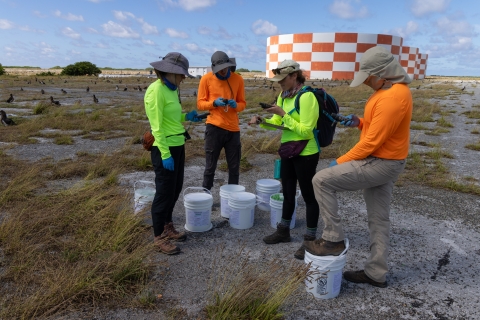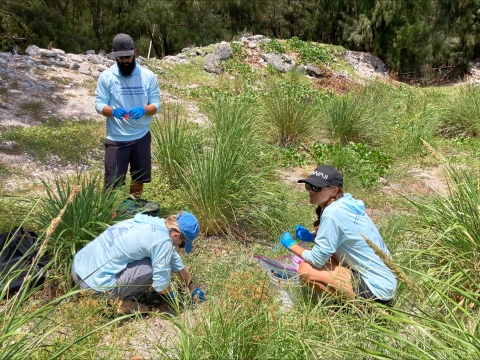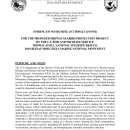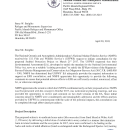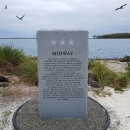Midway Atoll National Wildlife Refuge is famous for its seabirds, including the most famous bird in the world, Wisdom the Laysan albatross. However, the ground nesting seabirds of Midway's Sand Island are being threatened and preyed upon by house mice. Beyond predation of seabirds, the mice are known to have a disastrous effect across the entire island ecosystem, acting as a disease vector, altering the floral communities, competing with native species, degrading the quality of nesting habitat, preying upon terrestrial invertebrates, altering soil chemistry, and disrupting the intertidal community structure. The Seabird Protection Project was established to quell the mouse population through strategic applications in an effort to continuing on protecting and saving the seabirds of Midway.
Midway Seabird Protection Project Update #5 - August 15, 2023
Mitigation and Learning
Despite all best efforts, we’re still finding mice on Midway: A number of baiting options have been explored and tried to remove the remaining mice from Sand Island, but without success. It is disappointing, especially after so much planning and effort; however, as Thomas Edison once said, “I have not failed. I've just found 10,000 ways that won't work.” We are now ceasing further efforts to eradicate mice and transitioning into a learning and mitigation phase. Our efforts to protect wildlife, such as the Laysan duck and shorebirds from potential exposure to bait continues, as does our scientific protocol for environmental monitoring.
Although weather conditions were not optimal, the baiting operational plan was executed well and within constraints: We safely and effectively completed bait applications across Sand Island and eliminated human-based food sources as an alternative to the bait. Notwithstanding our best efforts, there are still mice present in many areas across Sand Island, and a root cause is not immediately evident.
There are theories, and questions, as to why mice persist on Sand Island. As the team transitions to a Mitigation and Learning Phase, we will continue to gather data to try to find answers. Environmental Monitoring, begun before the application of any bait and continuing throughout the project, can help us understand conditions on the ground. Additional studies can provide knowledge of Sand Island mouse foraging behaviors and food preferences, habitat anomalies, factors of weather and bait, and more. We will also continue to monitor the native wildlife for impacts from mice and take efforts to minimize predation on seabirds when we find it is occurring. The outcome of every rodent eradication effort is uncertain, and every project is an opportunity to learn more about rodents, rodent behavior, toxicants, mitigation of risk to non-target species, and other factors that can influence future restoration projects. Lessons learned on Midway will help inform this project and similar projects around the world.
In the meantime, there are plenty of successes to pay tribute to and continue to applaud. The team overcame enormous obstacles with more than 1,000 tenacious endangered Laysan ducks. Nearly all ducks were successfully translocated from Sand Island to Eastern Island where they continue to be cared for until they can safely return to Sand Island. No mice and no baiting occurred on Eastern Island. Thus far, more than 250 ducks that made their way back to Sand Island after baiting have been recaptured, cared for, and released back on Eastern Island while bait persists in Sand Island’s environment. Team members work long hours each day, making sweeps of wetlands early each morning to capture wayward duck travelers as soon as they arrive on Sand Island, assess them for indications of bait consumption, and provide any needed treatment before returning them to Eastern Island. New techniques and strategies for safely caring for the ducks have been developed and will continue to help inform conservation in the future. Mother Nature has helped too, as conditions in Alaska delayed the southward migrations of shorebirds this summer. Each day they stay away reduces their risk of exposure to degrading bait on Sand Island. Numbers of shorebirds at Midway are now increasing though, so the team is intensifying its diligent surveys for, and hazing of, foraging shorebirds. We are also beefing up shorebird attractants on Eastern Island for the migrants.
This phase of mitigation and learning will continue for the next few months. As the project winds down the team remains focused and dedicated to continuing to care for Midway’s wildlife and habitats. We embarked on this project with a shared vision of a Midway where native species can thrive on their island home. We remain committed to our goal of restoring and enhancing the atoll’s healthy ecosystem functions. When conditions are favorable again, the Laysan ducks and canaries will be returned to Sand Island and shorebirds will again be welcomed as seasonal residents before they again journey northward to their breeding grounds. The island community (i.e., the humans) is looking forward to fresh greens from the hydroponics garden and new growth of fruit on trees. The last of the albatross are fledging and the quiet of summer takes over – except for the nightly spectacle of Bonin petrels now returning from their brief absence from the atoll. The magic and mystery of Midway endures. It seems conservation is never easy, but it is always worthwhile…
Midway Seabird Protection Project Update #4 - August 8, 2023
Baiting
Bait is distributed three ways, each critical to project effectiveness. The aerial applications are done with a bait-spreading bucket slung below a helicopter, delivering bait relatively quickly and uniformly across the island. Sensitive areas (such as near interior ponds) receive bait via methodical and controlled hand-broadcasting by the FWS-Chugach ground team. Also all buildings and structures, including dry subterranean structures, were baited with bait boxes or bait bolas to reach inside buildings and Midway’s many varied structures. More than 1,800 bait boxes and bolas are deployed and regularly checked for uptake and bait condition.
Dennis the Hopper
Aerial operations went smoothly due to the teams expertise and talent and with the aid of a new tool for filling the bucket with bait. Using a new hopper specially constructed for this project, we safely and efficiently filled the bucket while reducing risk to crew and equipment. Affectionately called "Dennis" and standing roughly 10-feet tall, the hopper is made of heavy steel and able to stand securely despite the helicopter’s strong downwash. The process started with Chugach special projects team staging bait boxes for the day, opening and pre-positioning bags. Operating an excavator, the heavy equipment operator lifted each bag, turned, and hung each bag above Dennis while the loadmaster, who rigged quick-opening straps, released the suspended bag of bait into Dennis. After the bait is released, the excavator moved away to a safe position. When the Pilot flew the bucket in place below Dennis, load specialists discharged the bait from Dennis into the bucket. With a full bucket, the helo flew off to the target area, and using a geo-positioning tracking program, applied bait over the set swath. Baiting paths are tracked via GPS which is then logged into geospatial mapping softwear by GIS specialist to measure and track sow rates and identify any gaps.
Midway Seabird Protection Project Update #3 - July 25, 2023
It’s been a busy July on Midway. The Team has now completed all aerial bait applications on Sand Island, and did so within label prescription, on time, and safely without incident!
On July 10, when the rain cleared, the baiting team successfully applied a second 'supplemental' application of bait in the 'town area'. This application supplemented the first application to sustain better bait availability in town. It was an important addition because there are a lot of arthropods on Midway, especially in some of the fields around town, and the bugs consume a lot of bait (although it is not toxic to them). Fortunately, even though they eat a lot of bait, bugs are also a favorite food of Midway’s mice. The arthropods can provide a secondary pathway for mice to ingest bait.
Then, after a week of knuckle-biting weather watching for optimal conditions, July 20 and 21brought beautiful, albeit somewhat windy days, and we delivered the final application of bait over the whole island. Following the same format as the first and supplemental applications, the operation was smooth and efficient, safe and without incident. Like a well-oiled machine, the aerial baiting team expertly filled 127 buckets and the pilot distributed bait across Sand Island in the final application. Ground crews with hand-baiting and structures-baiting teams canvassed the island to complete the coverage, providing exposure to bait to every mouse on the island.
Along with baiting, the non-target team, human-based food team, operations, and monitoring for efficacy and environmental changes continued. It’s ‘all-hands-on-deck’ for non-target care. As of July 23, there are 20 endangered Laysan ducks in captive care on Sand Island, having been captured since baiting began.
Two ducks received full treatment for possible bait exposure, were released to Eastern Island, and are being monitored. Many members of our diverse project team are helping to care for ducks: from surveys for ducks, to giving feedings, to washing equipment, and cleaning up duck poop. The shorebird team also continues daily surveys and they also enlisted help from many team members to conduct an simultaneous all-island shorebird survey on Wednesday July 19 that found 15 bristle-thighed curlews, 69 ruddy turnstones, 18 Pacific golden plovers, and 4 wandering tattlers. Fortunately, colleagues in Alaska also continue to report that most satellite-tagged shorebirds are still enjoying their summer home and haven’t yet started the southern migration.
Human-based food (aka the professional handlers of all things trash (PHATT)) team continues to keep everyone up to date on food safety, trash incineration, and removal of alternate sources of mice-food such as prolific popolo berries from native shrubs. In the midst of all this, the Midway teams expertly sustain everyone with three delicious meals a day, maintenance of electric and plumbing, health and transportation, and runway operations.
With aerial baiting complete, the next phase of "Monitoring and Response" begins. The project continues on target... busy times, and doing good. Stay tuned!
Midway Seabird Protection Project Update #2- July 7th, 2023
Since the end of June 2023, Midway's population has risen to 88 people as Phase 2, Implementation Phase, began on mid June. It is a complex operation with many dedicated teams, each focusing on specific tasks necessary toward mission success. For example, with the support of the human-based-food team, alternate food sources have been made inaccessible to mice. The Laysan duck team has now successfully captured more than 1,100 Laysan ducks since January, transferred them to Eastern Island, and is now caring for and monitoring the population. The passerine team is caring for canaries they captured and are now in aviaries also located on Eastern Island. Hawaiian monk seals, honu (green turtle), and shorebirds are being surveyed daily.
As July began the baiting team successfully applied the first course of bait across Sand Island. The timing couldn’t have been more perfect on that week with dry weather. Monitoring teams have also established and are monitoring survey plots for wildlife status and application effectiveness. The project is proceeding as planned thanks to the skill and dedication of this talented and devoted team. The entire bait application process will take approximately one month to complete in order to ensure that Midway will become once again mice free. Now everyone is watching weather forecasts for continued success!
Project Update #1 - April 2023
The Midway Seabird Protection Project kicked off at the end of January 2023, when the Laysan duck team arrived at Midway to start Phase 1. The Laysan duck team has had great success capturing the ducks on Sand Island and moving them to Eastern Island. Between late January and early April 2023, the team captured and moved 968 Laysan ducks to Eastern Island. At Eastern Island, the Laysan ducks have everything they need in their temporary home.



